Buyer's Guide: 1956-1957 Continental Mark II
We'll Show You How This Rare Ford Motor Company Flagship Classic Offers Style, Luxury, And Solid Engineering At Surprisingly Reasonable Cost
03/13/2024

We'll Show You How This Rare Ford Motor Company Flagship Classic Offers Style, Luxury, And Solid Engineering At Surprisingly Reasonable Cost

Having inspired its arch-rival 1957-’58 Cadillac Eldorado Brougham, the Continental Mark II represented genuine American automotive royalty and the finest automobile this country could build in the early postwar era. Ford’s premium luxury coupe didn’t sell in large numbers, and for decades it could be purchased for less money than many lesser cars. Today’s sophisticated buyers have discovered how special this low-production two-door is, and demand for Mark IIs is rising along with their values.

Photography by Don Spiro
No! The 1956 and 1957 Mark IIs were not Lincolns, although subsequent Continental models would be. These cars were a product of the Ford Motor Company’s short-lived Continental Division, which traced its roots back to Edsel Ford’s pet project, the 1939 Lincoln-Continental that went into limited production between 1940 and 1948. The development of this new marque and model was led by Edsel and Eleanor Ford's youngest son, William Clay Ford.
Ford brass knew that an expensive halo car, following in the tire tracks of the original Lincoln-Continental, would likely be a money-loser, but felt the gains in publicity and prestige would make up for the loss. The design chosen for production was penned by Ford stylist John Reinhart, and the first Continental Mark IIs were built as 1956 models in October 1955.

Photography by Don Spiro
If you consider its impressive size, its tastefully understated styling, its ample power, and its standard luxury amenities, the Mark II could be called a postwar take on Depression-era opulence. The 218.4-inch-long coupe rode on a 126-inch wheelbase and weighed 4,825 pounds without air conditioning, 5,190 pounds so equipped. Its long, low lines were demure compared to its contemporaries, without resorting to tailfins or loud paint schemes; indeed, the car’s only styling gimmick, the trunk bulge that covered the upright spare wheel and harked back to the original Continental, would be featured on Lincolns for decades to come. Continentals did use a standard Lincoln V-8 engine and drivetrain whose output was on par with their contemporaries and afforded an indicated top speed of 118 mph.
And buyers of this car wanted for nothing, with virtually every powered convenience and luxury feature included at no additional cost. That list of standards included power steering, brakes, antenna, and power windows with tinted glass; a dual heating system; premium Travel-Tuner AM radio with two speakers; a self-regulating electric clock; a fully carpeted trunk; and an engine dress-up kit. If the Mark II's comprehensive equipment wasn't enough, a prospective owner could opt for bumper guards, a rear-window wiper, a factory-installed supercharger, or air conditioning- the latter most commonly selected. If A/C was installed, that system's evaporator unit was housed in the trunk (this means lots of piping from the front-mounted condenser, with potential leaks), and four registers were set in the headliner to deliver cool air to the occupants. The Continental's base price in 1956? $9,966, or roughly $114,700 in today’s dollars.

Photography by Don Spiro
The nascent Continental Division instituted a seven-point quality control program, and each Mark II -assembled in a newly completed plant engineered just for this model- required twice as many man-hours to build as did a contemporary Lincoln. Finished cars were transported to dealerships in fleece-lined plastic and canvas envelopes in an attempt to prevent shipping damage. The quality of materials used in these coupes was one of their best attributes, as Ford felt everything in its flagship should be the best. Chrome trim was heavily plated, and stainless was flash-chromed to match the finish of plated steel parts. The standard four-way power front seat could be covered in blemish-free Bridge of Weir Scottish leather, or numerous fabrics including matelassé, brocade, and broadcloth; in all, there were 43 standard upholstery trim choices to complement the 19 standard exterior lacquer finishes.

Photography by Don Spiro
Visually, this coupe changed very little, but there were notable mechanical updates, and the price actually dropped slightly, to $9,695 (around $106,400 today). Four new metallic paint colors joined the palette, and the air-conditioning air intakes were relocated from external scoops atop the rear fender kickups to ducting behind the grille. Engine output was increased from 285 to 300 horsepower. The Continental had new competition in the form of the Cadillac Eldorado Brougham four-door sedan in 1957, and this combined with falling sales in a soft luxury-car market to seal its fate; the Continental division was dissolved and the Mark II didn’t return for 1958, although a very different model called the Mark III Continental joined Lincoln’s lineup. The proposed Mark II sedan, folding-hardtop convertible, and fuel-injected engine never made it to production, and only 3,005 Mark IIs were built. It’s believed around 1,800 examples still exist; an online registry tracks survivors.

An interesting aspect of Mark II engine packaging: note how the exhaust manifold piping goes through the inner fenders before running outside of the frame rails to exit through openings in the rear bumper.
Photography by Don Spiro
Under special ribbed, die-cast aluminum rocker covers is same the 368-cubic-inch V-8 that powered the 1956-'57 Lincoln range and would be optional in 1957 Mercurys. This overhead-valve engine, a variant of Ford’s Y-block design, featured a 4.00 x 3.66-inch bore and stroke, five main bearings, and a 9.0:1 compression ratio. Fuel went through a four-barrel Holley 4000 carburetor into the engine to make 285 hp at 4,000 rpm and 402 lb-ft of torque at 3,000 rpm, and spent gasses were released through cast-iron manifolds, dual mufflers and resonators. In 1957, the ignition system was updated, the compression ratio increased to 10.0:1, and a Carter WCFB carburetor bumped power to 300 hp at 4,800 rpm and 415 lb-ft of torque at 3,000 rpm. New paper-based oil and air filters simplified maintenance.
This 368-inch V-8 was tuned to produce low- and mid-range torque via its big bore, large valves, and high valve lift, and strengthening measures included stronger pistons and a lightened, stiffer crankshaft. Oil pressure was ensured with a new rotary-type oil pump, and two air intake ducts led to the air filter- one over the exhaust manifold to warm incoming air, and the other directly from the grille for cool outside air. A thermostatically operated valve located at the junction of these ducts allowed the incoming air to mix, feeding the carburetor with air at a consistent temperature. And to make sure that they were finished to the highest standard, each completed engine was subjected to six hours of dyno testing before it was installed.
In some Ford and Mercury applications, the Y-block design developed a reputation for top-end oil starvation issues (due to offset block/head oil passages and infrequent oil changes or poor quality oil) and cooling system corrosion build-up; these were not complaints in the Lincoln/Continental 368. While a few instances of cracked piston skirts have been noted, this engine is widely respected for being resilient and long-lived.

Photography by Don Spiro
TRANSMISSION
The Mark II was intended to use General Motors’ four-speed Hydra-Matic transmission, but a fire in that assembly plant forced Ford engineers to proceed with Lincoln’s three-speed Turbo-Drive automatic. This unit used a 12 15/16-inch aluminum torque converter with planetary gearsets and forced air cooling, and it incorporated a kick-down function and low-gear start. Gear ratios were 2.40:1 in first, 1.47 in second, 1.00:1 in third, and 2.00:1 in reverse, and this transmission had to be in Neutral for the car to start. In 1957, the aluminum torque converter was swapped for a stronger 12-inch steel version, and an automatic transmission oil cooler was integrated into the radiator. This transmission’s components are durable, although failing piston seals or slipping can necessitate a rebuild, which -per Ford’s manuals- means pulling the anti-sway bar and engine first for access.
REAR AXLE
A Hotchkiss-type open hypoid differential with spiral bevel gears was used in the 1956 Continental Mark II; its semi-floating drive axles and 3.07:1 ratio made the car a comfortable cruiser. In 1957, the Mark II could be fitted with a Directed-Power limited-slip differential for greater foul-weather traction. Perishable bearings, gaskets, and seals are reproduced today.
SUSPENSION
The Mark II’s smooth ride was provided by an independent front suspension utilizing unequal-length A-arms, coil springs, ball-joint spindles, a link anti-sway bar, and tubular hydraulic automatic speed-compensating front shocks. The solid rear axle was suspended by longitudinally mounted semi-elliptical leaf springs and tubular hydraulic shocks. The Saginaw power steering, which offered a 22.1:1-ratio with 4 turns to lock and a 45.3-foot turning circle, was said to be predictably light with good tracking. New coil springs and hydraulic shocks can be purchased to freshen a tired car's ride and handling.
BRAKES
These Continentals were equipped with four-wheel drums with dual-servo assist; the 12 x 2.5-inch front and 12 x 2-inch rear units gave 207.7-square inches of lining via their riveted molded asbestos linings. The brakes sat behind 15 x 6-inch steel wheels with drop-center rims, mounting 8.00 x 15 (8.20 x 15 on 1957 cars with A/C) four-ply tires and unique full wheel covers. Like those on its contemporary Ford and Lincoln stablemates, Continental brake part replacements are available through many suppliers. It's even possible to update to discs for modern safety- a real benefit since the stock drums are taxed by the Mark II's weight.

The Mark II’s unusual frame design has one crossmember incorporating the power brake booster vacuum tank; check for solid metal behind the right front wheel.
Photography by Don Spiro
Due to this car’s substantial heft and its low 56.25-inch height, the Continental Division had to develop a new ladder-type frame for the Mark II; it used double-dropped square-tube steel construction with widened side rails and seven crossmembers. The floorpan’s dropped footwells on either side of the three-point driveshaft added passenger room, and the car’s dual exhausts were routed outside the frame rails for clearance before gasses exited through the rear bumper. This model has been found to rust in the standard places, so it’s imperative to check the quarter panels, the wheel openings in the fenders, and even around the headlamps; a small shelf behind the fender, below each headlamp, is noted for trapping water or dirt and leading to rust. Corrosion can also begin behind the stainless-steel molding at the bottom of the car.
Moving underneath, inspect the frame behind each front wheel, where the tubular crossmembers surrounded by flat frame rails are located; the sealed tube on the passenger side functions as a vacuum reservoir for the power brakes. That tube is known to rust, but can be repaired. The low-volume nature of this fine automobile means that new Mark II body panels are not available from the aftermarket, so craftspeople will need to repair or recreate damaged or missing sections of sheetmetal. There are a handful of Lincoln-exclusive suppliers that will happily assist you in locating good used body and trim parts, and nearly all exterior items are interchangeable between 1956 and 1957 cars.

A good upholstery shop can repair a Mark II’s interior by matching the top-quality original leather, fabric, and carpeting materials- be prepared for a substantial bill, though.
Photography by Don Spiro
The luxurious interiors of Mark IIs were filled with the finest materials; as expected, the vat-dyed Scottish Bridge of Weir leather upholstery was generally more durable than the alternative cloth choices. If a Continental’s interior looks tatty, a good trim shop should be able to recreate its original appearance and function using correct-style materials, and new headliners can be purchased pre-made. Replacement interior fabrics and reupholstered door panels are available from specialists like SMS Auto Fabrics, and replacement leather can be purchased from numerous sources. Be aware that the cost of materials can be substantial, as a leather-upholstered car uses up to seven hides! Deep-pile wool carpeting and interior hardware are also available, although missing trim will have to come from a donor car. The comprehensive dash instrumentation can be rebuilt, and replacement heater cores are available.

The Holley and Carter four-barrel carburetors fitted to Mark IIs were identical to those on Lincolns, and rebuild kits are commonplace.
Photography by Don Spiro
Many drivetrain components shared with Lincoln and Mercury models are easy to source, as are fasteners and some rubber components. Stock drum brake parts are available, and alternatively, drums can be converted to discs with a dual master cylinder. Wear items like gaskets and exhaust parts are still sold, and you can find recreations of most underhood decals. You may have to tap into a salvaged car to find parts for the complex, early factory air-conditioning system, the exterior moldings, and interior handles, though.
The helpful people in the Lincoln & Continental Owners Club will be happy to direct you towards the Lincoln/Continental specialist who can best assist you with your search for parts and information; a number of rough and restored Mark IIs, along with their parts suppliers, can be found in the “Lincoln” section of each month’s Hemmings, as well as in the Cars for Sale, Car Parts for Sale, and Car Services for Sale sections of our online Marketplace.

Photography by Don Spiro
Reputable value guides suggest that a 1956-’57 Continental Mark II in a retail setting is worth between $21,000 and $135,000, with prices averaging in the range of $34,000 to $50,000. Properly restored and untouched originals bring notably more than average-shape examples, and doing a proper restoration on a marginal car requires substantial investment. Classic.com considers the Mark II an appreciating Classic Market Benchmark at $75,994, and notes that, over the past five years, the average public-sale price of this FoMoCo flagship has been just under $61,000. The lowest price paid in this span was $2,200 for a 1956 project car at a 2022 Mecum auction in Chattanooga, Tennessee, while the highest was $715,000 for a fully customized 1957 restomod called “Cashmere,” at the 2024 Barrett-Jackson Scottsdale event.

Photography by Don Spiro

Photography by Don Spiro
800-576-2752
NOS, reproduction, and rebuilt mechanical and trim parts
727-446-2193
NOS, reproduction and used body, mechanical, and trim parts
Lincoln Farm
814-448-9311
lincolnfarm@breezeline.net
Used and salvage body, mechanical, and trim parts
The Lincoln/Mercury Old Parts Store
727-445-1091
New, used, and rebuilt mechanical, body, and trim parts
In addition to the specialist firms above, a search of Hemmings.com will turn up numerous Parts Locator articles highlighting Lincoln/FoMoCo parts and services suppliers.

Photography by Don Spiro
Lincoln & Continental Owners Club
P.O. Box 1715
Maple Grove, MN 55311-6715
763-420-7829
Dues: $34/year

Photography by Don Spiro
Preproduction: 16
1956: 2,417
1957: 572
Total production: 3,005
*figures courtesy of Jacob Dout, Lincoln & Continental Owners Club

Photography by Don Spiro
The quiet luxury and simple beauty of our 1957 Mark II photo car captivates its owner, James Feddick of Tucson, Arizona. "It's just about perfect, but I may be a bit prejudiced," he laughs. His Continental, repainted in its original Medium Tan Iridescent, was in good condition when he purchased it in 1981; the paint was badly faded, the air conditioning didn't work, and the transmission was sticking in second gear, but these were relatively easy fixes. "The engine has never been apart, and it's only got 52,000 miles on it," he says, reporting that it runs nicely on regular unleaded gasoline. "It drives like a big car -the frame under it is unbelievable compared to other cars of that time- but it handles very well and isn't loosely sprung. It's the next best thing to torsion bars...rigid, yet smooth." The Mark II is very comfortable on today's highways, James tells us; "Its natural speed is 75 mph, just as that of a Model A is 45 mph, and its engine is turning around 2,800 rpm at that speed. It's got plenty of power, yet there is very, very little wind noise at speed- it's just amazing." James cautions that the Mark II's power brakes are more sensitive than those of today, and that the air conditioning isn't as quick to cool, but is adequate. Because he has a number of collectible Studebakers and Avantis, James only drives the Mark II a few times a month. "Every now and then my wife will ask me, "Why don't we sell that? We don't use it very much," he recalls. "I just say 'But it's so pretty...'"
From the April 2005 (#7) issue of Hemmings Classic Car
Wagons are arguably the most practical form of transportation. By extending the relatively low roofline of its sedan counterpart, wagons offer plenty of precious cargo space while still retaining a lower center of gravity for zippy handling and spirited driving whenever the urge may hit. Despite all the fun that can be had in a wagon, massive high-riding SUVs and Crossovers have taken over the modern-day automotive market.
The SUV trend is unstoppable and new wagon models are becoming scarcer as years pass. Back in 1975, sedans and wagons dominated nearly 80-percent of the U.S. vehicle market. More recently, new SUV and truck sales have climbed to around 80-percent since 2011, taking the place of smaller sedans and their longroof model varieties.
In the classic car market, wagons are rapidly gaining popularity. Like the old saying goes, “They don’t make them like they used to.” Classic wagons exude a style that isn’t seen in today’s automobiles and car enthusiasts are gobbling them up like candy. Here are 15 examples of what is available in the classic wagon market today.
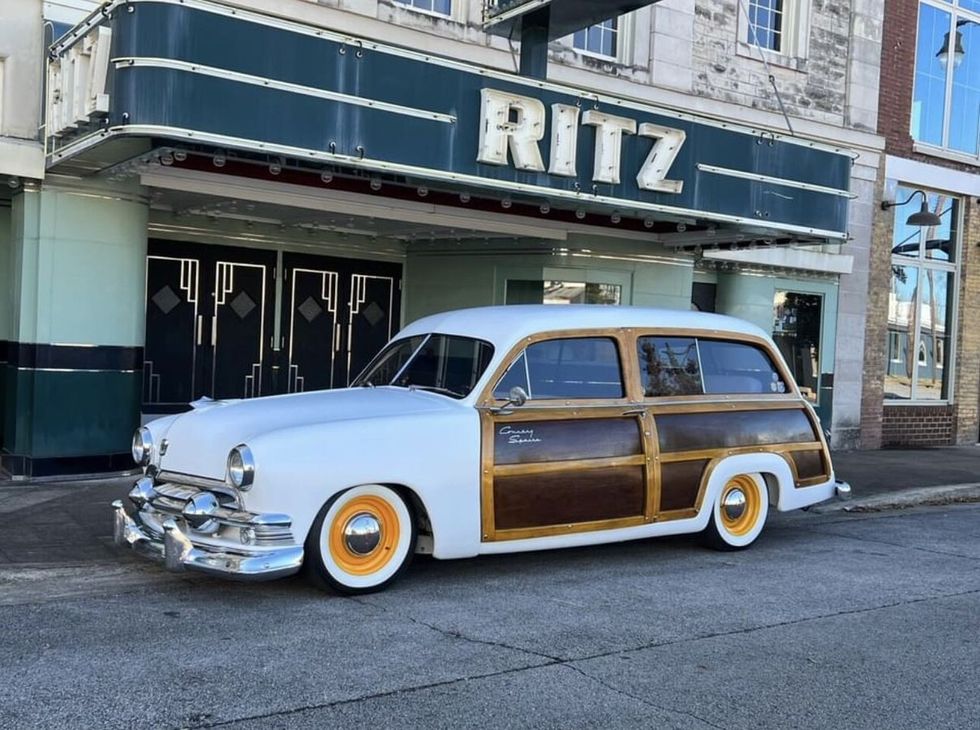
Everybody loves a classic woodie wagon! This two-door 1951 Ford Country Squire wagon still sports its original wood paneling, not that fake plasticky stuff seen on the more modern “wood” wagons. The seller states it is a fresh build that has only been driven 500 miles. A 350-cid Chevy Vortec Engine is hidden under the hood. Tasteful modifications include a Fatman Fabrications front end, an 8.8-inch rear end, power steering, four-wheel power disc brakes, and an all-new interior.
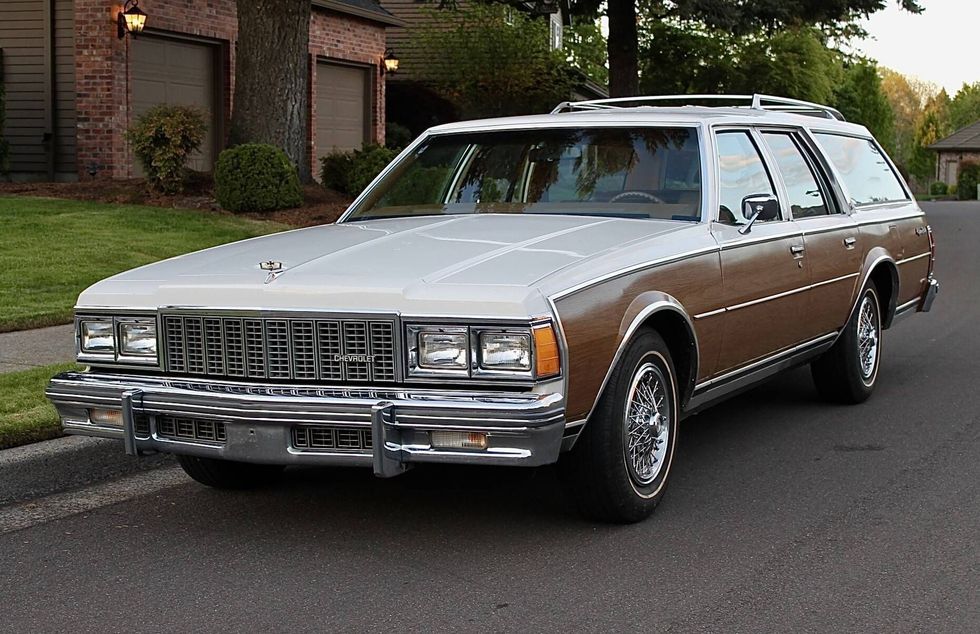
As stated in the auction listing, here’s a family hauler that would draw envious glances from Clark Griswold, this 1979 Chevrolet Caprice Classic Station Wagon is believed to be in original condition apart from maintenance and service requirements, according to the selling dealer, who acquired the woodgrain-trimmed wagon through an estate sale. There’s a 350 V8 under the hood and the seller notes service within the past few thousand miles has included new brakes, a new water pump and radiator, valve cover gasket, muffler, and more. Click here to see the full auction details.

“Experience the epitome of vintage charm and modern performance with the 1964 Mercury Colony Park, a California wagon that's been meticulously restored and upgraded to perfection. Underneath its classic blue exterior adorned with wood paneling lies a beastly 390-cid V8 engine, now equipped with a Holley Sniper EFI system for improved fuel efficiency and smoother power delivery. Paired with an automatic transmission, this wagon delivers a driving experience that's as effortless as it is exhilarating.”

This beautiful Brookwood underwent a professional frame-off custom restoration. It’s a restomod of sorts, still sporting its classic looks while implanting some modern creature comforts and technologies. It’s powered by a 480 horsepower LS3 engine paired with a six-speed manual transmission, for starters. Cruise to the classified to see more photos, plus the full list of custom goodies included in this immaculate 1959 Chevrolet Brookwood Nomad.
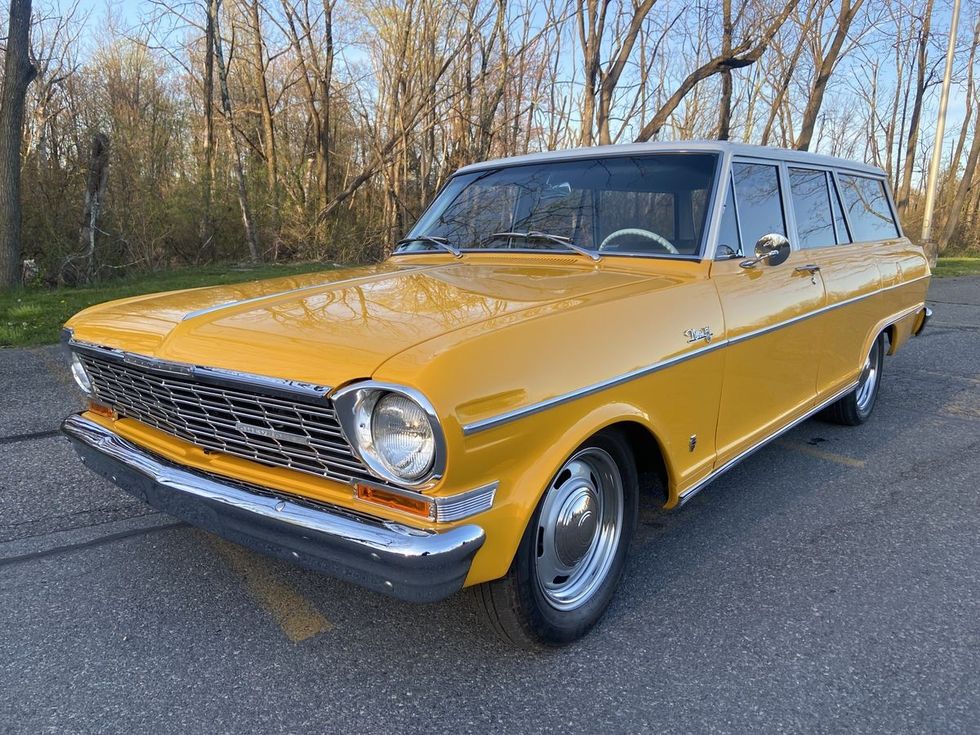
You’ll be hard-pressed to find a classic wagon exactly like this one-of-a-kind 1964 Chevrolet Chevy II Nova. Described as a mild restomod, this station wagon has just 1,000 miles accumulated since its frame-off restoration. The seller states that everything has been done on this car and it “rides, drives, and handles way better than you would expect; straight down the road with no shimmies, shakes, or vibrations.” The craftmanship on this V8-powered Chevy wagon is described as “simply spectacular.”
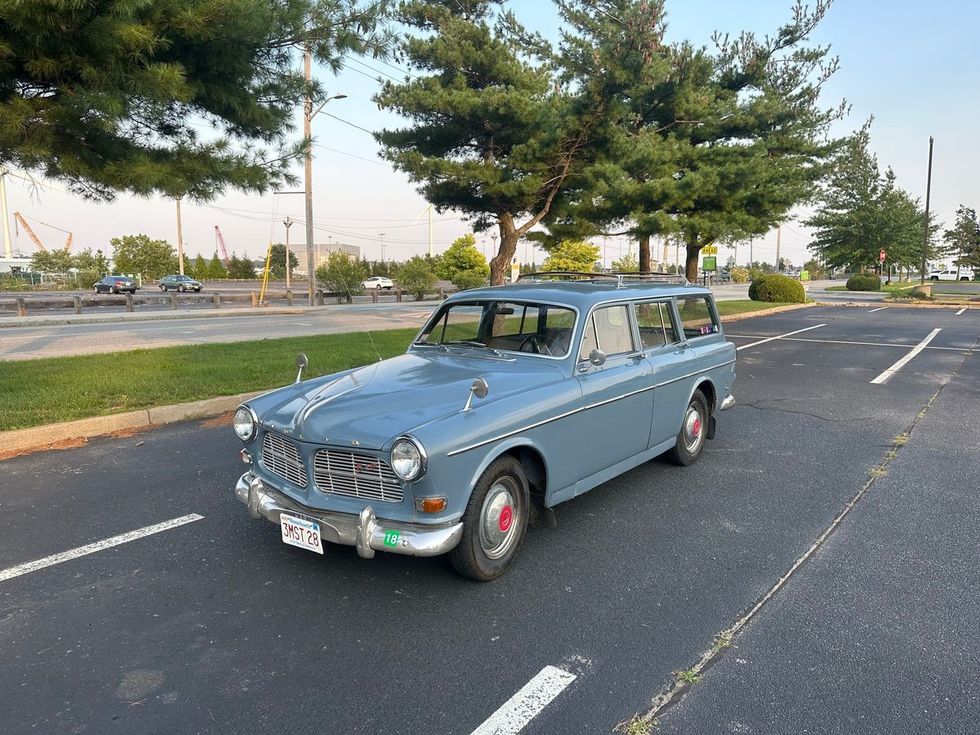
Volvo wagons are getting hard to come by, especially the 1960s-era cars. The seller states that this two-owner, mostly original 1963 Volvo 122S B22 was used as a daily commuter until a few years ago, has been regularly serviced, and is in good running condition with a recent fuel system overhaul. The original exterior does have some blemishes and surface rust, but the seller assures that “With a fresh paint job, she would really turn heads!”
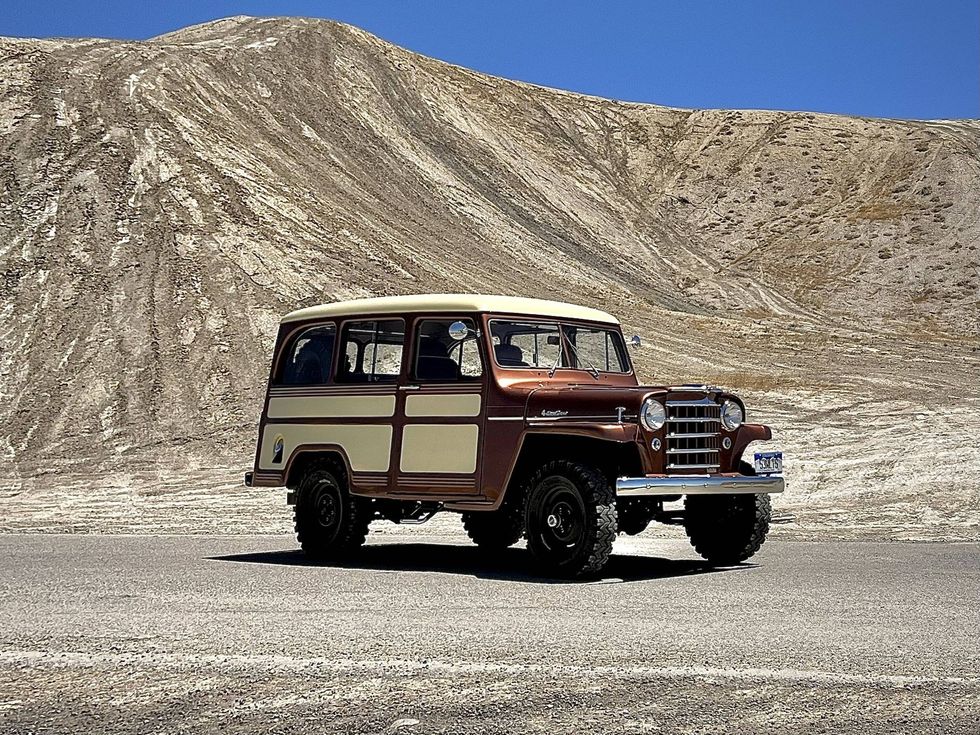
“There are refurbishments and restorations, and then there’s the kind of treatment this 1953 Willys Station Wagon has received. The work is described as a minutely detailed body-off restoration that has left the wagon in better-than-factory condition. Among the many non-production upgrades said to have been performed on this Willys are heated leather seats, a lamb’s wool headliner, a Pioneer audio system with Bluetooth capability, map lighting, and USB charging ports. The Willys is reported to have a replacement F-head engine of the same year and displacement, now rebuilt, and the wagon is described by the seller as free of rust.”

A muscle car in wagon form is what dreams are made of, especially when talking about the second-generation Chevrolet Chevelle SS. This example, a Placer Gold 1971 Chevrolet Chevelle SS Wagon, gets its power from a rebuilt 402 cubic-inch V8 producing 350 horsepower paired with a T-10 4-speed manual transmission geared with a 10-bolt rear end, plus other great features.
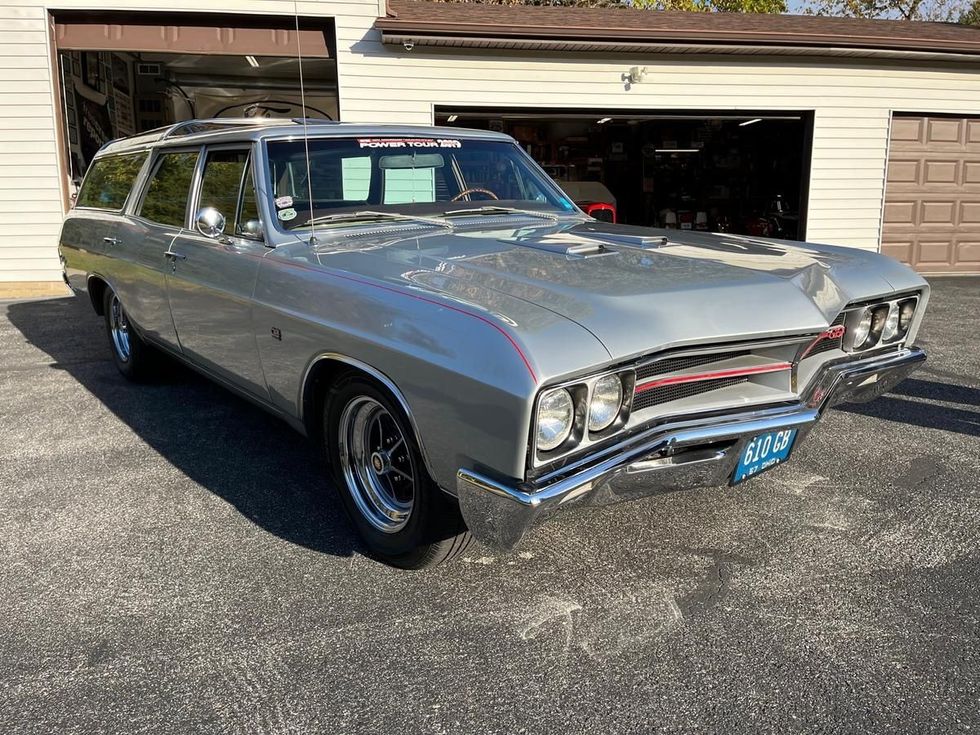
The sky roof (or panoramic roof) on this 1967 Buick Sport Wagon GS adds to this classic car’s luxurious feel. The seller states it is powered by a 350 cubic-inch small-block topped with four-barrel carbs and a Star Wars-style air cleaner. The wagon is described as rust free and ready to drive.

According to the seller of this custom 1956 Ford Parklane Two-Door Wagon, it is so clean that you can “eat off the door jams and spare tire well.” The mild custom sports a 312 cubic-inch V8 paired with an automatic transmission, plus loads of other goodies, including a custom interior. Take a close look at the photos supplied in the Hemmings Marketplace classified listing.
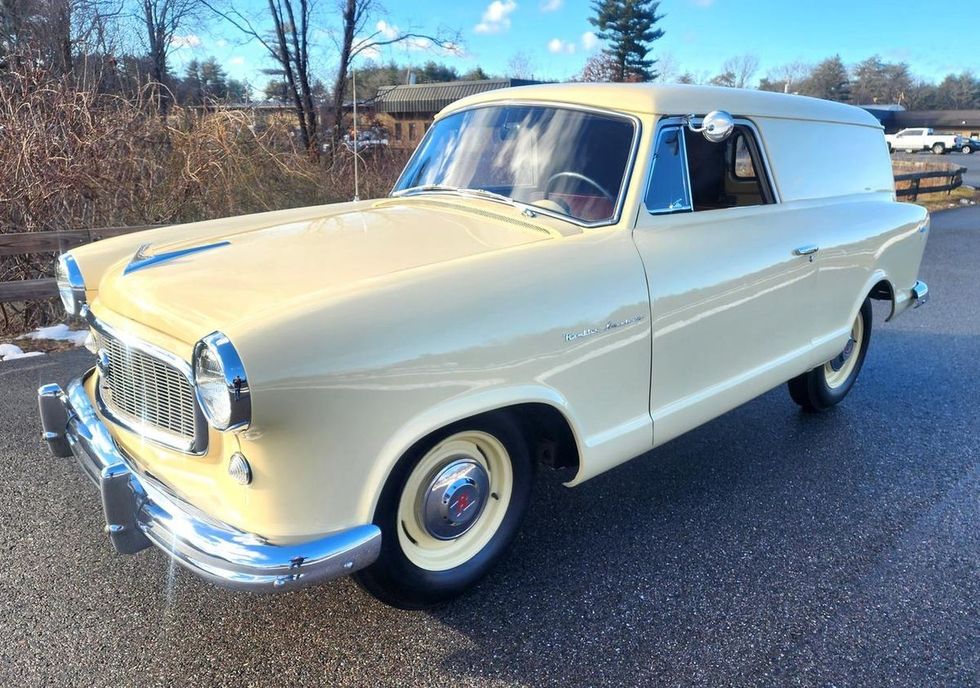
This extremely rare wagon is just one of only three examples produced, and the seller confirms that they do have the production records as proof. Previously owned and restored by the founder of the AMC club of America, the 1959 Rambler American Deliveryman Panel underwent what is described as an exceptional nut and bolt rotisserie restoration just a few years ago. It’s powered by an inline-six engine backed by a three-speed manual transmission, and the engine bay, among other details, is described as stunning.

The classic Chevrolet Bel Air embodies the American Dream of the late-50s, and its V8 engine signifies the era of American muscle. This elegant wagon is offered with an automatic transmission for easy cruising. The seller also states that the 1957 Chevrolet Bel Air is equipped with air conditioning, its classic AM radio, power brakes, and power steering.

If you’re searching for a wagon that will stop passersby in their tracks, look no further than this flame-adorned 1950 Oldsmobile. Under the hood you’ll find a powerful 5.7L Vortec 350 cubic-inch V8 paired with a smooth-shifting four-speed automatic transmission. The seller states, “this Oldsmobile Wagon is not just about looks and performance, it’s also equipped with a range of features designed to enhance your driving experience.” Get the full details here.

This unrestored 1959 Plymouth wagon shows 78,800 original miles on the odometer. The 318 polyhead Mopar engine is topped with a Holly two-barrel carburetor and exhales through a dual exhaust system. Don’t let the main photo of this beautiful machine on a trailer fool you: The seller states that the car is in survivor condition and it drives without issues. Check it out.

This two-door, six-passenger, V8-powered 1958 Edsel Roundup wagon is described by the seller as a no expense spared custom. The customizations were completed by its owner, Frank Montelone, alongside his long-time friend, the legendary George Barris of Barris Kustoms, which makes this custom wagon an incredibly rare find.
There are more wild wagons where these came from. As of this writing, there are around 50 classic wagon listings on Hemmings Marketplace. Take a look!
Ray pile was a part of the immediate post-World War II generation of hot rodders. During the war, he was a waist gunner in Boeing B-17 Flying Fortress bombers attacking Nazi-occupied Europe and afterward he returned to his home in Southgate, California. This is his car, the Pyle Special. Not much is known about its life before Ray got ahold of the Ford. It was just one of millions of Ford Model A’s produced for 1928-’31.
Just two years after the end of the war, an uncle got him set up running a gas station. That’s when the roadster comes on the scene, and with it, Ken Eichert, the father of current owner Chris Eichert and son of Ray’s benefactor-uncle.
Image courtesy of Chris Eichert
A mild-mannered, full-fendered roadster most of the time, one weekend each month the Pyle Special would transform into a race car bent on going as fast as possible on the dry lake beds northwest of Los Angeles.

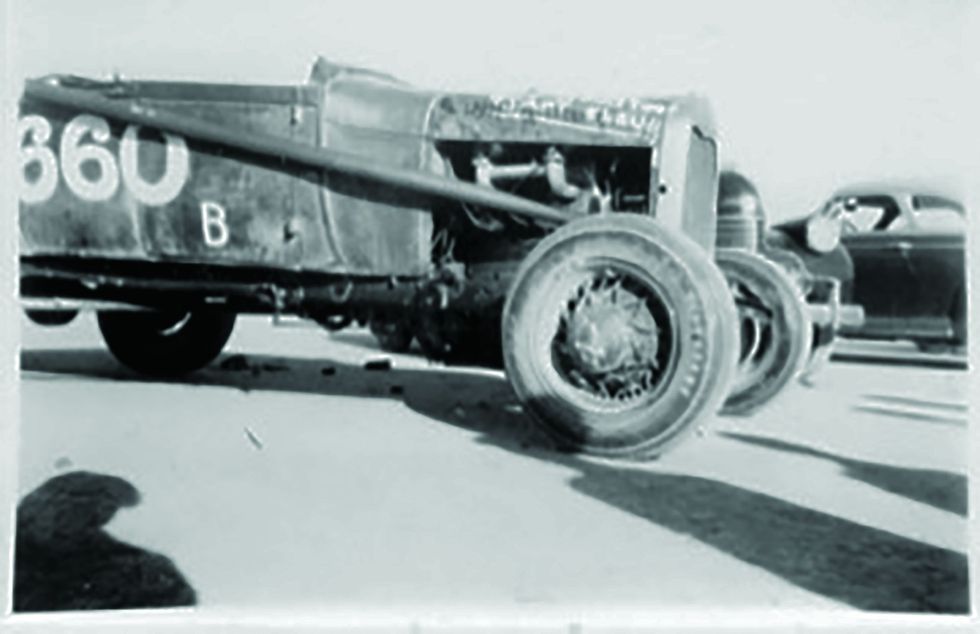

“Ray was my dad’s cousin on my grandmother’s side,” Chris says. Ken had survived a bout with polio earlier in life and was prevented from participating in most sports because of a bad leg. He discovered an outlet in the machines found at his older cousin’s shop and as an honorary member of his car club, the Gaters (note the intentional misspelling as a nod to Southgate).
“My dad was very active with Ray’s roadster. He tore it apart, worked on it, took off the fenders and installed the bomber seat for Ray to race on race day. From 1947 to 1949, Ray was going to the dry lakes with the Gaters, and the roadster was actually a dual-purpose vehicle: it ran full fendered on the street and was Ray’s get-around car, his family car, and then he would race it every month when they had a meet.”
The late hot rod historian Don Montgomery was adamant that the immediate post-World War II years represented the only pure expression of the hot rod: a true street/strip car that was driven by its owner/builder for transportation Monday through Friday and was stripped for racing on the weekends. Postwar racing for hot rods in Southern California circa 1946-’52 was largely either “the lakes”—meaning the dry lakes of the Mojave Desert, mostly El Mirage, or drag racing. At the tail end of the period, drag racing started to become formalized, on closed strips often comprised of aircraft runway infrastructure built for the war. Before that, acceleration contests were an informal activity done on public roads and facilitated by the popularity of drive-in restaurants.
Photo by Todd Ryden
This is the engine Ray raced at Santa Ana, originally built for him by Cook’s Machine Shop. Chris says it’s been drilled for full-pressure oiling, has had large valves installed, and had an unmarked but “really big” camshaft installed. It has since had fresh pistons and a milder cam installed. The Stromberg 81 carburetors are a smaller version of the 97, originally intended to equip 1937-’40 Ford 60-hp V-8 engines.



That three-faceted nature of postwar hot rods made them special and keeps them relatable today. Most roads in America are still suitable habitat for 1940s cars—whether they were new cars from 1947 or have been updated to 1940s technology. That ‘40s technology makes for a particularly satisfying operator experience—just automated enough not to be intimidating, but satisfyingly mechanical and interactive in all other respects. The sights, sounds, and smells are pure automobile, and the industrial design of every component says, “built right.”
Small wonder Chris decided to take the roadster back to how Ray had it. It even does a lot to explain why Chris’s father bought it off Ray in the mid-1960s, over a dozen years after it was last raced. It was far out of step with those times. It didn’t even have a flathead V-8. Ray had built the car to use four-cylinder power and its final engine had been a Model B unit, the 1932-’34 successor to the Model A four-cylinder and incorporating many of the popular modifications already done to make Model A engines suitable for high-performance applications.
“The motor that Ray raced with at the dry lakes was a four-banger with a two-port Riley,” Chris says. The Riley was an F-head design, or what the British and Harley-Davidson enthusiasts call “intake over exhaust,” meaning the exhaust valves retain their stock location in the block, but the intake valves are relocated overhead and actuated by pushrods and rocker arms. Even in flathead form, Model A and B four cylinders were respected for their off-the-line performance while the Ford V-8 was capable of greater top-end speed. An OHV or F-head conversion on a four-cylinder usually meant it was capable of keeping up with a flathead V-8 even at those higher RPMs. Chris would love to someday replicate that engine, which he and Ken discovered in derelict condition shortly after Ray’s death in 1987 and deemed unsalvagable.
The roadster’s final outings were to what was then Santa Ana airport. The first modern dragstrip began operation there in the spring of 1950 and Ray quit driving the Pyle Special about 1951. It didn’t move again until 1964 or ’65, when Ray sold it to Ken, who in turn held onto the car more as a keepsake than an active project. As a child, Chris would sneak into the freestanding garage where it was stored and sit in it and later it would provide plenty of father/son bench racing and swap-meet parts buying episodes.
Aside from one brief-but-memorable ride, the car sat in storage until 2007. By that point, it had suffered a couple indignities: its engine sold off to a friend’s speedster project and one fender and splash apron were brutally disfigured in a freak accident involving a large stack of tile.
“My dad was getting older. I told him I wanted to get the roadster going and he told me to bring it over. I took it completely apart and I cleaned off decades and decades of dirt. I actually saved some of it, thinking it was probably El Mirage dirt. I have two cigar vials full.”
That cleaning and disassembly venture was a crash course in postwar-era hot rodding.
Photo by Todd Ryden
The front axle was dropped back in the 1940s and installed on the roadster circa 1950. To further lower the roadster, the spring eyes were reversed on both the front spring and in the rear.




“Nothing was precisely done. It was a real trip to see what hot rodders did back then and how they put stuff together. It truly was like going back all those years. Then seeing how it evolved in the late ‘40s into the ‘50s in old pictures, as it became what it is today.
“I ended up buying the motor back from the friend with the speedster. I told him what we were going to do, and he did not hesitate to sell it back to us. I had a friend of my dad’s rebuild the motor.”
Chris then re-installed all the speed parts that had come from Ray, plus a few his father had collected along the way, notably twin Stromberg 97 two-barrel carburetors on an Evans intake and a Mallory dual-point distributor. Chris also discarded Ray’s rear-only mechanical brake setup for 1939 Ford hydraulic brakes contributed by a friend of his father. “That’s the kind of friends my dad had,” he says. “All his hot rod friends knew about the roadster and when I told them I was working on it, they gave him stuff.”
Once the roadster was going, there followed a whirlwind of father-son activity with it, culminating in the twin delights of a Hot Rod Magazine feature story of the still-in-primer roadster, and Ken getting to drive the roadster at El Mirage for the first time ever. Then, Ken died in 2011 and the roadster took another hiatus.
“After Dad died, it sat. I could not get the motor running for snot. I took it to three or four old guys who worked on old Model A’s, hot rod guys, they couldn’t get it running. I kept spending money to no result, so I mothballed it for another 10 or 12 years, from 2011 to about a year or so ago.”
Photo by Todd Ryden
“It’s a rattle can, but the coolest rattle can you could ever be in. I still drive it and have memories of my dad and wish he were there and could share the moments. Even though I didn’t know Ray, I think of him. He got this up to 116 mph and that’s a feat. I’ve probably gone no faster than 65 mph and it scared me, I couldn’t imagine doing 116.”



For help, Chris turned to a fellow member of the revived Gaters club, welder/fabricator and hardcore enthusiast of midcentury Americana, Randy Pierson.
“He’s got a period army tent, a period camp stove, he tows his roadster with a ’49 Merc four-door. The body on his roadster is all handmade. He is the pinnacle for our group who keeps us true to that era and what we do and what we don’t do and what we put our signature on as a club as far as being period correct.
“He did some body work (but he said it was one of the nicest Model A bodies he’d ever worked on). It was all hand welded, hand hammered, hand finished. We stripped off down to the color that was consistently across most of the body. He rewired it with cloth wire as it would it have been in period, and he really was meticulous to getting it back to as it was in 1947. We looked at pictures. He kept what he could keep and mimicked what needed to be done to make it true to its 1940s life.”
Also mimicking its 1940s life was the scramble to get it ready for race day. In this case, the West Coast iteration of The Race of Gentlemen, which is not a beach race but is instead held at Flabob Airport in Riverside, California, in the style of the original Santa Ana drags.

Although it still rides on a Model A frame, at some point the k-shaped crossmember from a 1932 Ford was installed, which stiffens the chassis slightly and provides built in mounts for the later transmission and floor pedals. Ray apparently lacked the tools to shorten the driveshaft, however, which pushed the engine and transmission forward slightly. During the rebuild, Chris and Randy moved the radiator back to its stock position to run an original-style hood.
Photo by Todd Ryden
“We found a bomber seat and just a couple weeks before the race, Randy had started to work on the motor to get it running and he too could not get it running right. He pulled it apart and he’s not a motor guy, but he knows enough, and one of his neighbors is an old hot rodders. We changed out the 97s to 81s because the 97s were a lot of carburetor for that little banger motor, especially in duals. Then he still had a hard time. We took out the cam, put in adjustable lifters, and at the very last second, we were trying to find a different cam for it, because we figured there was something going on with the cam. I asked a buddy if he had anything to go in my roadster and he sold me a cam and I sent all that up to Randy, who worked on it feverishly for a week to ship it back down for the races. He got it running and when he got to drive it down the street, he was surprised. ‘This thing has got it. This thing scoots.’ It runs really strong.”
That strong running paid off in a lot of fun at TROG West, giving truth to one more of Ken’s old stories.
“My daughter has a video of me racing a T/V-8 and I pass the camera behind the T, but by the time I get to the finish line, I’ve beat her. It brings back memories of my dad telling me ‘Yeah, that motor will beat some V-8’s.’ It’s one of those moments, again, of my dad’s stories from all those years ago having proof in their pudding. Those revelations keep happening.”
What’s next for this old racer? “I never did get it registered when I moved from California to Texas,” Chris says, “but I am going to get it registered.”
Hopefully, it will be back on the streets soon, paying tribute to that triple-threat nature of hot rodding’s golden era.
Photo by Todd Ryden
“We reproduced the tailpipe that’s on it from pictures. It’s built from 1938 driveshaft enclosures because of the taper they have at one end. When Ray was racing it, that’s one of the things my dad put on it every time, so that’s what we did when we were putting it back together. It’s got a killer, throaty sound to it.”

